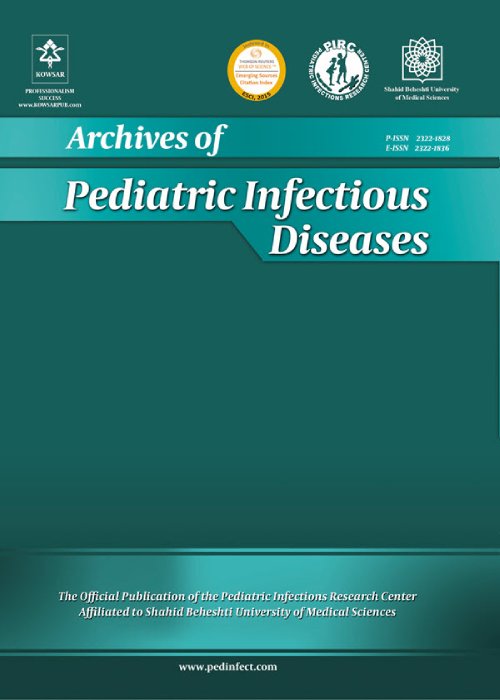Frequency of Candida Species Isolated from Patients in Children's Medical Center, Tehran, Iran
Author(s):
Article Type:
Research/Original Article (دارای رتبه معتبر)
Abstract:
Background
Candida species originating from either endogenous or exogenous sources are one of the main causes of opportunistic infections. Colonization is an important independent risk factor for invasive candidiasis, and many patients admitted to neonatal intensive care unit (NICU) and pediatric intensive care unit (PICU) are colonized with Candida species that may result in invasive candidiasis. Awareness among clinicians about various aspects of colonization is critical to optimal management. The aim of this study was to determine the frequency and species distribution of Candida strains isolated from predisposed patients hospitalized at Childrens Medical Center (CMC), Tehran, Iran.Methods
From June 2014 to June 2016, 347 Candida isolates were collected from 341 patients either hospitalized in different wards or referred as outpatients. The yeasts were identified by colony color characteristics using CHROMagar Candida medium and by amplification of the ITS1-5.8S rDNA-ITS2 region in DNA extracted from each isolate followed by analysis of species specific electrophoretic patterns of PCR products digested with the restriction enzyme MspI.Results
Of the 341 patients, 213 were males and 128 were females. Most samples were obtained from the 1 12-month age group, and the majority of samples represented urine (n = 182), throat swabs (n = 57), and stool samples (n = 53), respectively. The samples were mostly from patients in general wards. The most commonly isolated species was C. albicans (77%), followed by C. tropicalis (8.4%), C. parapsilosis (7.5%), C. glabrata (2.3%), C. kefyr (1.7%), C. krusei (1.1%), C. lusitaniae (0.6%), C. guilliermondii (0.3%), C. albicans C. parapsilosis (1.4%), and C. albicans C. glabrata (0.3%).Conclusions
C. albicans is the most common species isolated from children in Iran, followed by C. tropicalis and C. parapsilosis, a prevalence pattern that is relatively different from studies in other countries. Neonates and infants 1 - 12 months of age hospitalized in ICU, were more colonized by Candida species than other groups.Keywords:
Language:
English
Published:
Archives of Pediatric Infectious Diseases, Volume:6 Issue: 1, Jan 2018
Page:
1
magiran.com/p1785578
دانلود و مطالعه متن این مقاله با یکی از روشهای زیر امکان پذیر است:
اشتراک شخصی
با عضویت و پرداخت آنلاین حق اشتراک یکساله به مبلغ 1,390,000ريال میتوانید 70 عنوان مطلب دانلود کنید!
اشتراک سازمانی
به کتابخانه دانشگاه یا محل کار خود پیشنهاد کنید تا اشتراک سازمانی این پایگاه را برای دسترسی نامحدود همه کاربران به متن مطالب تهیه نمایند!
توجه!
- حق عضویت دریافتی صرف حمایت از نشریات عضو و نگهداری، تکمیل و توسعه مگیران میشود.
- پرداخت حق اشتراک و دانلود مقالات اجازه بازنشر آن در سایر رسانههای چاپی و دیجیتال را به کاربر نمیدهد.
In order to view content subscription is required
Personal subscription
Subscribe magiran.com for 70 € euros via PayPal and download 70 articles during a year.
Organization subscription
Please contact us to subscribe your university or library for unlimited access!


